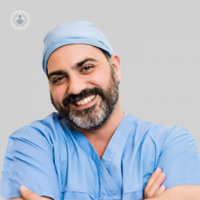Gynaecomastia and muscle dysmorphia: Is there a link?
Autore:Gynaecomastia is a common condition that can affect males from all age groups, from newborn babies to teenage boys and older men. One or both breasts can be involved.
Here to provide an expert insight into gynaecomastia, including risk factors and surgical treatment, is Dr John Skevofilax, renowned dual specialist orthopaedic and plastic surgeon.

What is gynaecomastia? What causes it?
Gynaecomastia is a condition that causes male breasts to swell and enlarge, developing to look like female breasts. What usually causes it is a hormone imbalance, when the body produces more oestrogen than testosterone hormones. This can happen during adolescence when teenage boys are physically changing and becoming men.
Nowadays, however, the highest risk for gynaecomastia is steroid use. Men use steroids to grow their muscles, but it reaches a point that when they try to decrease their steroid dose, this actually stops their regular testosterone growth. This leads to an overproduction of oestrogen, and this hormone imbalance can also cause gynaecomastia.
Other causes of gynaecomastia include eating certain foods, smoking marijuana, drinking alcohol and even obesity, because fat itself also produces oestrogen.
How can gynaecomastia relate to muscle dysmorphia?
Many men who take testosterone do it to look more ‘manly’, mostly because they are preoccupied with the way that they look.
For instance, I had a patient who had been married for 10 years. In all those years, his wife had never seen his chest: he would go to sleep with his shirt on; he would go to the beach with his shirt on; he would even take a shirt with him to the shower so that he could quickly put it on after he was done.
Another one of my patients would always leave his shirt on when he went with his children to the beach. One day came when he wanted to go down a waterslide with his daughter. The staff told him that he had to take his shirt off or not get on the waterslide at all. My patient chose to not go down the waterslide. It was during this moment that he realised that he needed to get medical help for his dysmorphia and possibly, consider surgery.
Due to gynaecomastia, many men do not feel good about themselves. This is because gynaecomastia can seem like a feminine trait to have in a man, and a great number of people are not accepting of this.
Is it dangerous?
No, gynaecomastia is actually safe.
The surgical procedure for gynaecomastia is performed under local anaesthetic, in which the patient is completely awake.
The duration of surgery is approximately an hour for a regular procedure. If it is a chest lift, which is the biggest operation that can be performed for gynaecomastia, then this can take about three hours. Patients generally do not feel any pain, but they may feel a bit of discomfort in the beginning when anaesthesia is being administered.
The worst complication that I have ever seen following surgery is a hematoma, which occurs when blood pools under the skin in the area where gynaecomastia surgery has been performed. However, blood can be drained if this happens.
Other than hematoma, the risks of gynaecomastia surgery are pretty low for everything else. Patients can also combat the risk of infection with antibiotics. Even with regards to scarring, many of the times, scars do not even show.
How is gynaecomastia treated? Can lifestyle changes help?
If gynaecomastia is just at its earliest stages, I believe that patients could change their lifestyle to treat it. There are different things that could be done, but after gynaecomastia starts to develop (where the fibrous tissue grows underneath the chest), then it will not improve unless surgery is performed.
If weight is lost and if this is mostly fat, then gynaecomastia will obviously shrink. However, it is important to know that the fibrous tissue cannot be gotten rid of.
When should patients see a specialist about gynaecomastia?
Patients should see a specialist when gynaecomastia has become a concern. It is an individual decision. Obviously, if gynaecomastia reaches a point where it has become a huge, hanging breast, then patients have waited too long to get effective treatment.
Some patients are also not concerned by their gynaecomastia. However, if gynaecomastia is at its beginning stages, patients have started noticing it and it is something that is of concern, then a specialist should be seen for it right away.
If you are concerned about your gynaecomastia and wish to seek specialist care for it, do not hesitate to visit Dr Skevofilax’s Top Doctors profile today.


